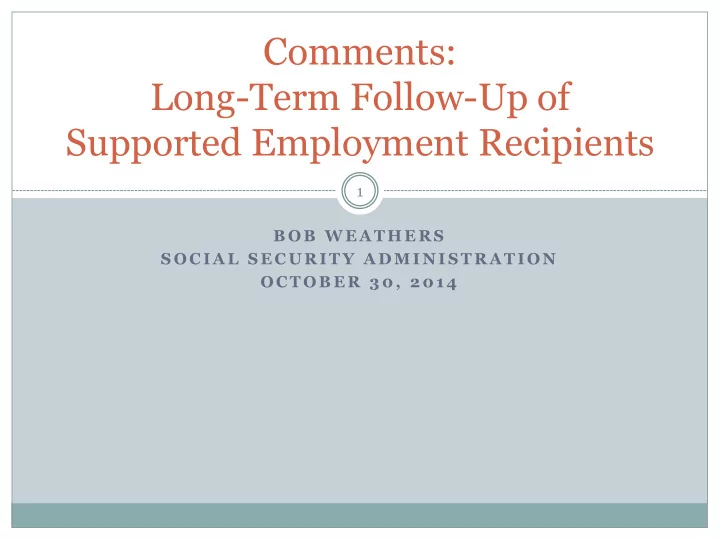

Comments: Long-Term Follow-Up of Supported Employment Recipients 1 B O B W E A T H E R S S O C I A L S E C U R I T Y A D M I N I S T R A T I O N O C T O B E R 3 0 , 2 0 1 4
Policy Relevance 2 A significant share of SSDI beneficiaries and SSI recipients have mental health conditions Among all DI beneficiaries, primary diagnosis: mood disorders (14.1%), schizophrenic and other psychotic disorders (5.1%) Among all SSI recipients ages 18-64, primary diagnosis: mood disorders (16.5%), schizophrenic and other psychotic disorders (8.9%) SSDI beneficiaries with mental health conditions tend to be younger and stay on the program longer Relatively lower incidence rates indicate longer stay on program Among all DI awardees: Mood Disorders (9.6%), Schizophrenic and other psychotic disorders (2.2%) Among all SSI recipients ages 18-64: Mood Disorders (13.0%), Schizophrenic and other psychotic disorders (5.6%) Providing services and supports to individuals with mental impairments may: improve functioning, employment, and earnings; and reduce reliance on SSDI and SSI programs. A unique feature of the Cook et al paper is the analysis of long-term outcomes of individuals who received Supported Employment services
Paper’s Key Findings 3 Among group who received EIDP SE, over 13 yr follow-up: no statistically significant difference in any reported earnings (adjusted OR = 1.27, p=.253) more likely to ever be suspended from SSI/DI due to work (adjusted OR = 2.05, p=.024) more total earnings (average about $3,000 more, p=.092) More likely to collect SSDI benefits, less likely to collect SSI payments Person-month panel regressions tend to show larger effects Result of Supported Employment or sample selection? Uses subsample who agreed to additional survey and to merge SSA records, treatment group member who benefited more likely to agree? Persistence of the SE effect on employment is somewhat surprising given experience with other demonstrations Providing additional information on baseline characteristics of each group might be useful in assessing possible selection bias
Comparison to MHTS 4 SSA/Westat Mental Health Treatment Study (MHTS) included: access to supported employment (SE) services and systematic medication management (SMM) services begun in November 2006 and ended July 2010 included 2,238 SSDI beneficiaries in 23 study sites throughout the U. S. random assignment of volunteers to either a treatment group or a control group primary goal was to examine impact on competitive employment MHTS Findings: positive impact on health and healthcare outcomes ( reduction in hospital days was about one day per year, or approximately $1,800 per year per person); positive impact on employment during 24 month intervention period(61% v. 40% control group); positive impact on monthly earnings, conditional on having earnings ($251.12 vs. $227.93) ; no effect on SGA (SGA amount was $900/month in 2007, $1000/month in 2010); and no effect on benefit suspense/termination Goal of competitive employment may not translate into reduced reliance on benefits
What Next? 5 MHTS and EIDP long-term outcomes analyses: both focused on SSDI beneficiaries and SSI recipients application and program participation might have negative effects on labor market outcomes Can a focus earlier in the impairment process (before DI/SSI receipt) increase employment, earnings, and economic well-being? Is the SE focus on competitive employment too limiting? should the focus be on Substantial Gainful Activity (SGA)? or maximizing a person’s employment and earnings potential?
Opportunities to Build on SE Findings 6 Early intervention demonstration authority: Focus on SE services to denied applicants with mental impairments? Focus on SE services on SSI/DI applicants with mental impairments before SSA disability determination? Affordable Care Act (ACA) Health Homes: ACA established Health Homes to coordinate care for people with Medicaid who have chronic conditions Conditions include “one serious and persistent mental health condition” Health Homes providers integrate and coordinate all primary, acute, behavioral health, and long-term services and supports to treat the whole person Supports could include Supported Employment services? ACA expands Medicaid to those with incomes up to 138% of poverty line State Medicaid “buy - in” option may cover individuals with a disability and incomes up to 400% of poverty line
Recommend
More recommend